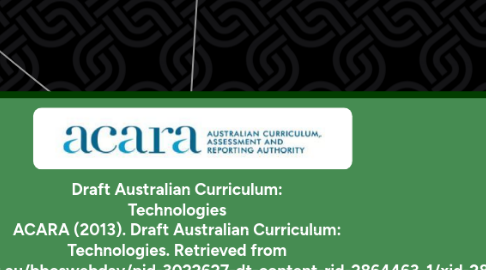
1. Learning area information
1.1. General learning area information
1.1.1. Rationale: Technology guides and sustains humanity. As teachers, we need to help create individuals to effectively utilise and create new technologies, create individuals who can work independently and collaboratively - with people of all ages and abilities - on innovative and complex jobs to contribute to sustainable patterns of living. The use and creation of technology directs the course of humanity.
1.1.1.1. Aims: The attributes of successful students in the learning area.
1.1.1.1.1. Students effectively utilise and create things using technology
1.1.1.1.2. Students know the history of technology are implement that knowledge of it's past and present in creating technology for the future
1.1.1.1.3. Students create and discuss technology, and its use in solving potential problems
1.1.1.1.4. Students use the whole creation process, from design to evaluation, to solve problems
1.1.1.1.5. Confidently utilise technology in a responsible manner, for themselves, for the greater global community, and the planet.
1.2. Specific leaning area information
1.2.1. Design and Technologies Rationale: Students create products, services, and environments through design and development. These designs can impact the natural managed, constructed and digital environments. They create quality designs with various technologies independently and collaboratively. They can critique their own work and their peers, discerning quality and purpose, as well as project's sustainability.
1.2.1.1. Aims:
1.2.1.1.1. "Document design ideas and communicate these to a range of audiences"
1.2.1.1.2. "Select and manipulate a range of materials, components, tools and equipment creatively, competently and safely in the development of designed solutions suitable for a range of technologies contexts"
1.2.1.1.3. "Explore, investigate, create and critique innovative, ethical and sustainable designed solutions for preferred futures using a range of technologies"
1.2.1.1.4. "Develop confidence as critical users and designers and producers of technologies and designed solutions"
1.2.1.1.5. "Understand the roles and responsibilities of designers, technologists and those in related occupations."
1.2.2. Digital Technologies Rationale: In such a high-tech world, students need to learn how to deal with technologies in an ethical manner. Students learn to design solutions that combat potential future scenarios. Digital technologies allows students hands on experience that fosters their 'curiosity, confidence, persistence, innovation, creativity, respect, and cooperation.
1.2.2.1. Aims:
1.2.2.1.1. "Design, create, manage and evaluate sustainable digital solutions to meet and redefine current and future needs of individuals, societies, economies and environments"
1.2.2.1.2. "Frame problems and create solutions using the computational thinking concepts of abstraction; data collection, representation and interpretation; specification, algorithms and implementation; digital systems; and interactions and impact"
1.2.2.1.3. "Use digital systems to efficiently and effectively automate the transformation of data into information and to creatively communicate ideas in a range of formal and informal settings"
1.2.2.1.4. "Apply protocols and legal practices that support safe, ethical and respectful communications and collaboration with known and unknown audiences when developing social and intellectual capital"
1.2.2.1.5. "Monitor, analyse, predict and shape the interactions within and between information systems and the impact on individuals, societies, economies and environments."
2. Organisation:
2.1. General capabilities: Knowledge, skills, behaviours, and dispositions that will create 21st century savvy adults.
2.1.1. Literacy (LIT)
2.1.2. Numeracy (NUM)
2.1.3. Information and communication technology (ICT) capability
2.1.4. Critical and creative thinking (CCT)
2.1.5. Personal and social capability (PSC)
2.1.6. Ethical understanding (EU)
2.1.7. Intercultural understanding (ICU)
2.2. Cross-curriculum priorities: Overarching concepts that are found in every content area at varying levels.
2.2.1. Aboriginal and Torres Strait Islander histories and cultures
2.2.2. Asia and Australia's engagement with Asia
2.2.3. Sustainability
2.3. Links to other learning areas: Utilising knowledge and skills taught in other learning areas.
2.3.1. English
2.3.2. Mathematics
2.3.3. Science
2.3.4. History
2.3.5. Geography
2.3.6. The Arts
2.3.7. Health and Physical Education
2.4. Student diversity:
2.4.1. Students with disability
2.4.2. English as an additional language or dialect
2.4.3. Gifted and talented students
2.5. Learning area content:
2.5.1. Strands: The areas that are used to assess students.
2.5.1.1. Knowledge and understanding - These are the comprehension skills learnt from the subject.
2.5.1.1.1. "Design and Technologies knowledge and understanding – the use, development and impact of technologies and design ideas across a range of technologies contexts"
2.5.1.1.2. "Digital Technologies knowledge and understanding – information systems: data, processes, digital systems, people, and their interactions"
2.5.1.2. Processes and production skills - These are the physical skills learnt from the subject.
2.5.1.2.1. "Design and Technologies processes and production skills – the skills required to design, produce and evaluate designed solutions."
2.5.1.2.2. "Digital Technologies processes and production skills – defining and solving problems through using digital systems, critical and creative thinking and applying computational thinking."
3. Content Band: Years 3-4
3.1. Design and Technologies:
3.1.1. Strands:
3.1.1.1. Design and Technologies knowledge and understanding
3.1.1.1.1. Technologies and society
3.1.1.1.2. Technologies contexts
3.1.1.1.3. Materials and technologies specelisations
3.1.1.1.4. Food and fibre production
3.1.1.1.5. Engineering principles and systems
3.1.1.1.6. Food technologies
3.1.1.2. Design and Technologies processes and production skills
3.1.1.2.1. Critiquing, exploring, and investigating
3.1.1.2.2. Generating, developing, and evaluating ideas
3.1.1.2.3. Planning, producing, and evaluating designed solutions
3.2. Digital Technologies:
3.2.1. Strands:
3.2.1.1. Digital Technologies knowledge and understanding
3.2.1.1.1. Representation of data
3.2.1.1.2. Digital systems
3.2.1.1.3. Interactions and impact
3.2.1.2. Digital Technologies processes and production skills
3.2.1.2.1. Managing and analysing data
3.2.1.2.2. Using digital systems
3.2.1.2.3. specification, algorithms, and implementation
3.2.1.2.4. Creating and interacting online
